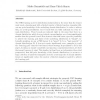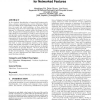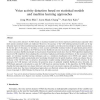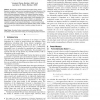155
click to vote
JMLR
2012
13 years 3 months ago
2012
We prove logarithmic regret bounds that depend on the loss L∗ T of the competitor rather than on the number T of time steps. In the general online convex optimization setting, o...
155
click to vote
ICANN
2011
Springer
14 years 4 months ago
2011
Springer
Abstract. In many supervised learning tasks it can be costly or infeasible to obtain objective, reliable labels. We may, however, be able to obtain a large number of subjective, po...
116
click to vote
TCS
2011
14 years 7 months ago
2011
The PAC-learning model is distribution-independent in the sense that the learner must reach a learning goal with a limited number of labeled random examples without any prior know...
121
Voted
TASLP
2011
14 years 7 months ago
2011
—This paper presents a novel student model intended to automate word-list-based reading assessments in a classroom setting, specifically for a student population that includes b...
111
click to vote
ICDM
2010
IEEE
14 years 10 months ago
2010
IEEE
Abstract--Most well-known discriminative clustering models, such as spectral clustering (SC) and maximum margin clustering (MMC), are non-Bayesian. Moreover, they merely considered...
127
click to vote
CIKM
2010
Springer
14 years 10 months ago
2010
Springer
In the standard formalization of supervised learning problems, a datum is represented as a vector of features without prior knowledge about relationships among features. However, ...
116
Voted
ECCV
2010
Springer
14 years 11 months ago
2010
Springer
Compressive sampling (CS) is aimed at acquiring a signal or image from data which is deemed insufficient by Nyquist/Shannon sampling theorem. Its main idea is to recover a signal ...
113
click to vote
CSL
2010
Springer
14 years 11 months ago
2010
Springer
The voice activity detectors (VADs) based on statistical models have shown impressive performances especially when fairly precise statistical models are employed. Moreover, the ac...
93
Voted
PAMI
2000
15 years 16 days ago
2000
94
Voted
TNN
2008
15 years 19 days ago
2008
In this paper, a supervised neural network training technique based on constrained optimization is developed for preserving prior knowledge of an input




